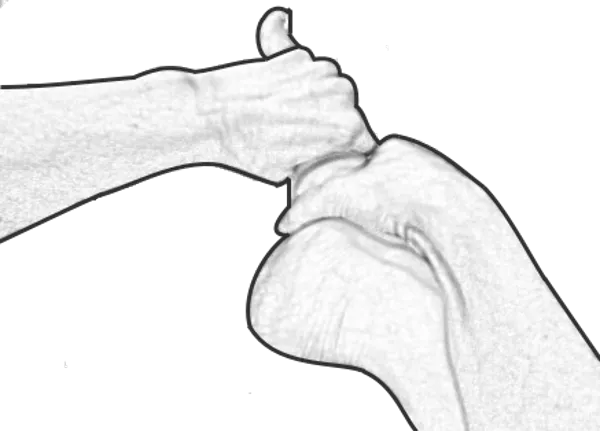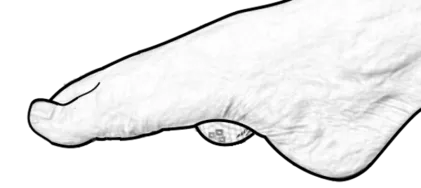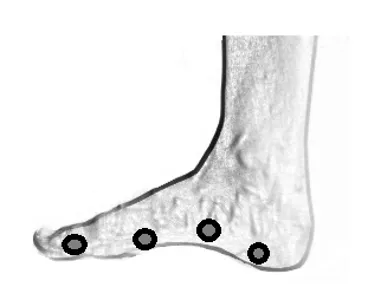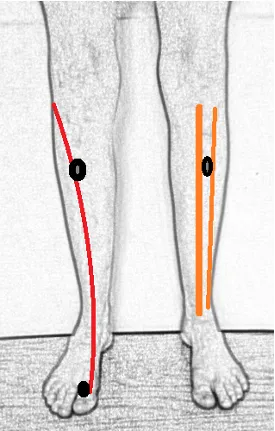MOBILIZING TECHNIQUE FOR THE FEET

Mobilizing the bones in the arches of the foot.
To loosen the tarsal bones of your foot, you can grab your foot as pictured in Figure 20-12. Apply a wringing action (like you are trying to wring out a wet towel). This will loosen your tarsal and metatarsal bones. Moving the bones feeds the joints, wrings out inflammatory metabolic waste, creates space for the nerves, and allows for better lymphatic drainage and blood flow, all of which facilitates healing.
Frequency is more important than intensity or duration because it generally just takes a minute or two to drain the foot of its metabolic waste, but within an hour (if not minutes) it can refill. So take a moment every hour throughout the day to drain your foot of metabolic waste.
FOOT MASSAGE TOOLS
All kinds of foot massaging tools are available to treat foot pain, but you don’t have to spend a lot of money on high-tech gadgets.
A cheap massage option is to roll the bottoms of your feet on a golf ball, as shown in Figure 20-13.

Using a golf ball to massage the bottom of the foot.
This works best on carpeted flooring (so the golf ball doesn’t shoot out from under the foot). Another option is to put the golf ball in a sock to better control its location under the foot as you roll your foot back and forth on the ball.
Make sure to use enough pressure to massage the muscles, but not so much pressure that you bruise the bottom of your foot.
You can even use an ice cube to massage your feet, or roll your foot on a frozen water bottle as described.
Pressure Point Massage for the Feet
To work out any pressure points in your feet (Figure 20-9), start by running your fingers along the arch of your foot and see if you find any tender spots. If you find one, press on it for three breaths and then release. Wiggle your toes to see how it feels. If it feels a little better, repeat the pressure until it feels a lot better (up to three times because you do not want to over-treat and inflame the tissues).
Each time you press on the tender spot, it should be less tender. The tenderness decreases as the excess metabolic waste in the muscle is squished out of the muscle, up the lymphatic vessels toward the heart. The metabolic waste is dumped into the blood stream at the thoracic duct and eventually gets filtered out by your kidneys. If the tenderness does not improve with each squeeze, seek the advice of a massage therapist, chiropractor, and/or physical therapist.
Pressure Points in the Lower Leg
The spots pictured above and below are the locations of common pressure points in the lower leg.
Look for points around your ankles that are tender. Tenderness indicates lymphatic blockage or muscle tension, and tells you that something needs to be worked out. Applying pressure here could potentially alleviate foot pain.
Pressure points in the front of the leg.
Then feel the meaty part of the front lower leg between the two long bones (the tibia and fibula; Figure to the left) and see if you have tender spots there. If you do, press and hold for three breaths to see if this helps your foot pain.
I find that it is better to do frequent, gentle cycles of pressure point therapy than to do intense pressure a few times a week. I teach my patients how to do the therapy themselves so their symptoms do not return between their sessions with me.
If you are here in Bloomington, Indiana, schedule with us and we can help you determine what is wrong with your foot (or feet), help you address it naturally or refer you to the best medical specialist for your specific needs.
You don't have to suffer or be in pain. Why wait?
to schedule with us.
Drummond Chiropractic, LLC
Foot Pain Specialists
565 N Walnut St
Bloomington, IN 47404
(812) 336 - 2423



